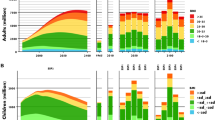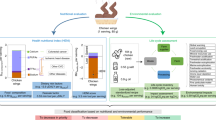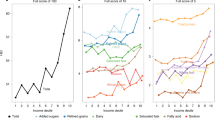Abstract
Changing what foods we eat could reduce environmental harms and improve human health, but sweeping dietary change is challenging. We used dietary intake data from a nationally representative sample of 7,753 US children and adults to identify simple, actionable dietary substitutions from higher- to lower-carbon foods (for example, substituting chicken for beef in mixed dishes such as burritos, but making no other changes to the diet). We simulated the potential impact of these substitutions on dietary carbon emissions and dietary quality. If all consumers who ate the high-carbon foods instead consumed a lower-carbon substitute, the total dietary carbon footprint in the United States would be reduced by more than 35%. Moreover, if adopted, these substitutions would improve consumers’ overall dietary quality by 4–10%, with benefits projected for all age, gender, and racial and ethnic groups. These results suggest that a ‘small changes’ approach could be a valuable starting point for addressing diet’s impact on climate and health.
This is a preview of subscription content, access via your institution
Access options
Access Nature and 54 other Nature Portfolio journals
Get Nature+, our best-value online-access subscription
$29.99 / 30 days
cancel any time
Subscribe to this journal
Receive 12 digital issues and online access to articles
$119.00 per year
only $9.92 per issue
Buy this article
- Purchase on Springer Link
- Instant access to full article PDF
Prices may be subject to local taxes which are calculated during checkout


Similar content being viewed by others
Data availability
This study used data from the NHANES and dataFRIENDS. NHANES data are publicly available from the Centers for Disease Control website (https://wwwn.cdc.gov/nchs/nhanes/). DataFIELD is available at http://css.umich.edu/page/datafield, and dataFRIENDS is available at https://sph.tulane.edu/sbps/diet-environmental-impacts.
Code availability
All code is available at https://github.com/clee321/NATFOOD-dietarysubs.
References
Poore, J. & Nemecek, T. Reducing food’s environmental impacts through producers and consumers. Science 360, 987–992 (2018).
Crippa, M. et al. Food systems are responsible for a third of global anthropogenic GHG emissions. Nat. Food 2, 198–209 (2021).
Afshin, A. et al. Health effects of dietary risks in 195 countries, 1990–2017: a systematic analysis for the Global Burden of Disease Study 2017. Lancet 393, 1958–1972 (2019).
Willett, W. et al. Food in the Anthropocene: the EAT–Lancet Commission on healthy diets from sustainable food systems. Lancet 393, 447–492 (2019).
Rose, D., Heller, M. C. & Roberto, C. A. Position of the Society for Nutrition Education and Behavior: the importance of including environmental sustainability in dietary guidance. J. Nutr. Educ. Behav. 51, 3–15.e1 (2019).
Harmon, A. H., Gerald, B. L. & American Dietetic Association. Position of the American Dietetic Association: food and nutrition professionals can implement practices to conserve natural resources and support ecological sustainability. J. Am. Diet. Assoc. 107, 1033–1043 (2007).
Scientific Report of the 2015 Dietary Guidelines Advisory Committee: Advisory Report to the Secretary of Health and Human Services and the Secretary of Agriculture (United States Department of Agriculture and Department of Health and Human Services, 2015); https://health.gov/our-work/nutrition-physical-activity/dietary-guidelines/previous-dietary-guidelines/2015/advisory-report
Clark, M. A., Springmann, M., Hill, J. & Tilman, D. Multiple health and environmental impacts of foods. Proc. Natl Acad. Sci. USA 116, 23357 (2019).
Nelson, M. E., Hamm, M. W., Hu, F. B., Abrams, S. A. & Griffin, T. S. Alignment of healthy dietary patterns and environmental sustainability: a systematic review. Adv. Nutr. 7, 1005–1025 (2016).
Van Horn, L. et al. Recommended dietary pattern to achieve adherence to the American Heart Association/American College of Cardiology (AHA/ACC) guidelines: a scientific statement from the American Heart Association. Circulation 134, e505–e529 (2016).
Willits-Smith, A., Aranda, R., Heller, M. C. & Rose, D. Addressing the carbon footprint, healthfulness, and costs of self-selected diets in the USA: a population-based cross-sectional study. Lancet Planet. Health 4, e98–e106 (2020).
Conrad, Z., Drewnowski, A., Belury, M. A. & Love, D. C. Greenhouse gas emissions, cost, and diet quality of specific diet patterns in the United States. Am. J. Clin. Nutr. 117, 1186–1194 (2023).
Rose, D., Heller, M. C., Willits-Smith, A. M. & Meyer, R. J. Carbon footprint of self-selected US diets: nutritional, demographic, and behavioral correlates. Am. J. Clin. Nutr. 109, 526–534 (2019).
Pollock, B. D., Willits-Smith, A. M., Heller, M. C., Bazzano, L. A. & Rose, D. Do diets with higher carbon footprints increase the risk of mortality? A population-based simulation study using self-selected diets from the USA. Public Health Nutr. 25, 2322–2328 (2022).
O’Malley, K., Willits-Smith, A. & Rose, D. Popular diets as selected by adults in the United States show wide variation in carbon footprints and diet quality. Am. J. Clin. Nutr. 117, 701–708 (2023).
Scarborough, P. et al. Vegans, vegetarians, fish-eaters and meat-eaters in the UK show discrepant environmental impacts. Nat. Food. 4, 565–574 (2023).
Hill, J. O., Wyatt, H. R., Reed, G. W. & Peters, J. C. Obesity and the environment: where do we go from here?. Science 299, 853–855 (2003).
Roberto, C. A. et al. Patchy progress on obesity prevention: emerging examples, entrenched barriers, and new thinking. Lancet 385, 2400–2409 (2015).
Leng, G. et al. The determinants of food choice. Proc. Nutr. Soc. 76, 316–327 (2017).
Sobal, J., Bisogni, C., Devine C. & Jastran, M. A Conceptual Model of the Food Choice Process over the Life Course. In The Psychology of Food Choice (eds Shepherd, R. & Raats, M.), 1–18 (CABI, 2006); https://doi.org/10.1079/9780851990323.0001
Bandura, A. Health promotion from the perspective of social cognitive theory. Psychol. Health. 13, 623–649 (1998).
Hill, J. O. Can a small-changes approach help address the obesity epidemic? A report of the Joint Task Force of the American Society for Nutrition, Institute of Food Technologists, and International Food Information Council. Am. J. Clin. Nutr. 89, 477–484 (2009).
Rose, D., Willits-Smith, A. M. & Heller, M. C. Single-item substitutions can substantially reduce the carbon and water scarcity footprints of US diets. Am. J. Clin. Nutr. 115, 378–387 (2022).
Racial and Ethnic Disparities in Heart Disease (Centers for Disease Control and Prevention, 2019); https://www.cdc.gov/nchs/hus.htm
Flegal, K., Kruszon-Moran, D., Carroll, M., Fryar, C. & Ogden, C. Trends in obesity among adults in the United States, 2005 to 2014. JAMA 315, 2284–2291 (2016).
By the Numbers: Diabetes in America (Centers for Disease Control and Prevention, 2022); https://www.cdc.gov/diabetes/health-equity/diabetes-by-the-numbers.html
Heller, M. C., Willits-Smith, A., Meyer, R., Keoleian, G. A. & Rose, D. Greenhouse gas emissions and energy use associated with production of individual self-selected US diets. Environ. Res. Lett. 13, 044004 (2018).
Willits-Smith, A. Food Choices in the United States: Opportunities for Health and Sustainability Co-benefits. Doctoral dissertation, Tulane Univ. (2022).
Farchi, S., Sario, M. D., Lapucci, E., Davoli, M. & Michelozzi, P. Meat consumption reduction in Italian regions: health co-benefits and decreases in GHG emissions. PLoS ONE 12, e0182960 (2017).
Jarmul, S. et al. Climate change mitigation through dietary change: a systematic review of empirical and modelling studies on the environmental footprints and health effects of ‘sustainable diets’. Environ. Res. Lett. 15, 123014 (2020).
Krebs-Smith, S. M. et al. Update of the Healthy Eating Index: HEI-2015. J. Acad. Nutr. Diet. 118, 1591–1602 (2018).
Reedy, J. et al. Evaluation of the Healthy Eating Index-2015. J. Acad. Nutr. Diet. 118, 1622–1633 (2018).
Panizza, C. E. et al. Testing the predictive validity of the Healthy Eating Index-2015 in the multiethnic cohort: is the score associated with a reduced risk of all-cause and cause-specific mortality? Nutrients. 10, 452 (2018).
Hu, E. A., Steffen, L. M., Coresh, J., Appel, L. J. & Rebholz, C. M. Adherence to the Healthy Eating Index-2015 and other dietary patterns may reduce risk of cardiovascular disease, cardiovascular mortality, and all-cause mortality. J. Nutr. 150, 312–321 (2019).
Beal, T. & Ortenzi, F. Priority micronutrient density in foods. Front. Nutr. 9, 806566 (2022).
Dietary Guidelines for Americans, 2020–2025 (United States Department of Agriculture and Department of Health and Human Services, 2020); https://www.dietaryguidelines.gov
Sun, H. & Weaver, C. M. Decreased iron intake parallels rising iron deficiency anemia and related mortality rates in the US population. J. Nutr. 151, 1947–1955 (2021).
Stylianou, K. S., Fulgoni, V. L. & Jolliet, O. Small targeted dietary changes can yield substantial gains for human health and the environment. Nat. Food. 2, 616–627 (2021).
Lacroix K. et al. Understanding Differences in Americans’ Motivations for Eating Plant-Rich Foods (Yale Program on Climate Change Communication, 2022); https://climatecommunication.yale.edu/publications/understanding-differences-in-americans-motivations-for-eating-plant-rich-foods/
Leiserowitz, A., Ballew, M., Rosenthal, S. & Semaan, J. Climate Change and the American Diet (Yale Univ. and EarthDay Network, 2020).
Blondin, S., Attwood, S., Vennard, D. & Mayneris, V. Environmental Messages Promote Plant-Based Food Choices: An Online Restaurant Menu Study (World Resources Institute, 2022); https://www.wri.org/research/environmental-messages-promote-plant-based-food-choices-online-restaurant-menu-study
Roberto, C. A. & Kawachi, I. Introduction to Behavioral Economics and Public Health. In Behavioral Economics and Public Health (eds Roberto, C. A. & Kawachi I.), 1–27 (Oxford Univ. Press, 2015).
Shan, Z. et al. Association between healthy eating patterns and risk of cardiovascular disease. JAMA Intern. Med. 180, 1090–1100 (2020).
Figures & Infographics Dietary Guidelines for Americans (US Department of Agriculture and US Department of Health and Human Services, 2020); https://www.dietaryguidelines.gov/figures-infographics
Mathur, M. B. Ethical drawbacks of sustainable meat choices. Science 375, 1362 (2022).
Desilver D. Americans say they’re changing behaviors to help the environment—but is it making a difference? Pew Research Center https://www.pewresearch.org/short-reads/2019/12/19/americans-say-theyre-changing-behaviors-to-help-the-environment-but-is-it-making-a-difference/ (2019).
Forwood, S. E., Ahern, A. L., Marteau, T. M. & Jebb, S. A. Offering within-category food swaps to reduce energy density of food purchases: a study using an experimental online supermarket. Int. J. Behav. Nutr. Phys. Act. 12, 1 (2015).
Koutoukidis, D. A. et al. Prominent positioning and food swaps are effective interventions to reduce the saturated fat content of the shopping basket in an experimental online supermarket: a randomized controlled trial. Int. J. Behav. Nutr. Phys. Act. 16, 50 (2019).
Jansen, L., van Kleef, E. & Van Loo, E. J. The use of food swaps to encourage healthier online food choices: a randomized controlled trial. Int. J. Behav. Nutr. Phys. Act. 18, 156 (2021).
Sparkman, G. & Walton, G. M. Dynamic norms promote sustainable behavior, even if it is counternormative. Psychol. Sci. 28, 1663–1674 (2017).
Wolfson, J. A., Musicus, A. A., Leung, C. W., Gearhardt, A. N. & Falbe, J. Effect of climate change impact menu labels on fast food ordering choices among US adults: a randomized clinical trial. JAMA Netw. Open 5, e2248320 (2022).
Meier, J., Andor, M. A., Doebbe, F. C., Haddaway, N. R. & Reisch, L. A. Review: Do green defaults reduce meat consumption? Food Policy 110, 102298 (2022).
Reisch, L. A. et al. Mitigating climate change via food consumption and food waste: a systematic map of behavioral interventions. J. Clean. Prod. 279, 123717 (2021).
Pechey, R., Hollands, G. J., Reynolds, J. P., Jebb, S. A. & Marteau, T. M. Is altering the availability of healthier vs. less-healthy options effective across socioeconomic groups? A mega-analysis. Int. J. Behav. Nutr. Phys. Act. 19, 88 (2022).
Pechey, R. et al. Impact of increasing the proportion of healthier foods available on energy purchased in worksite cafeterias: a stepped wedge randomized controlled pilot trial. Appetite 133, 286–296 (2019).
Bianchi, F., Garnett, E., Dorsel, C., Aveyard, P. & Jebb, S. A. Restructuring physical micro-environments to reduce the demand for meat: a systematic review and qualitative comparative analysis. Lancet Planet. Health 2, e384–e397 (2018).
Garnett, E. E., Balmford, A., Sandbrook, C., Pilling, M. A. & Marteau, T. M. Impact of increasing vegetarian availability on meal selection and sales in cafeterias. Proc. Natl Acad. Sci. USA 116, 20923–20929 (2019).
Marteau, T. M., Hollands, G. J., Pechey, R., Reynolds, J. P. & Jebb, S. A. Changing the assortment of available food and drink for leaner, greener diets. BMJ 377, e069848 (2022).
New York City’s public school system goes meat-free on Fridays. Reuters https://www.reuters.com/world/us/new-york-citys-public-school-system-goes-meat-free-fridays-2022-02-04/ (2022).
Sievert, K., Lawrence, M., Parker, C. & Baker, P. Understanding the political challenge of red and processed meat reduction for healthy and sustainable food systems: a narrative review of the literature. Int. J. Health Policy Manag. 10, 793–808 (2020).
Hurrell, R. & Egli, I. Iron bioavailability and dietary reference values. Am. J. Clin. Nutr. 91, 1461S–1467S (2010).
Allen, L. H., Carriquiry, A. L. & Murphy, S. P. Proposed harmonized nutrient reference values for populations. Adv. Nutr. 11, 469–483 (2020).
Cheng, L. et al. A 12% switch from monogastric to ruminant livestock production can reduce emissions and boost crop production for 525 million people. Nat. Food 3, 1040–1051 (2022).
Aleksandrowicz, L., Green, R., Joy, E. J., Smith, P. & Haines, A. The impacts of dietary change on greenhouse gas emissions, land use, water use, and health: a systematic review. PLoS ONE 11, e0165797 (2016).
Godfray, H. C. J. et al. Meat consumption, health, and the environment. Science 361, eaam5324 (2018).
Moshfegh, A. J. et al. The US Department of Agriculture Automated Multiple-Pass Method reduces bias in the collection of energy intakes. Am. J. Clin. Nutr. 88, 324–332 (2008).
National Cancer Institute Summary tables: recommendations on potential approaches to dietary assessment for different research objectives requiring group-level estimates. National Cancer Institute Dietary Assessment Primer (National Cancer Institute, accessed 8 October 2023); https://dietassessmentprimer.cancer.gov/approach/table.html
Blanton, C. A., Moshfegh, A. J., Baer, D. J. & Kretsch, M. J. The USDA Automated Multiple-Pass Method accurately estimates group total energy and nutrient intake. J. Nutr. 136, 2594–2599 (2006).
Rhodes, D. G. et al. The USDA Automated Multiple-Pass Method accurately assesses population sodium intakes. Am. J. Clin. Nutr. 97, 958–964 (2013).
Zhang, F. F. et al. Assessing dietary intake in childhood cancer survivors: food frequency questionnaire versus 24-hour diet recalls. J. Pediatr. Gastroenterol. Nutr. 61, 499–502 (2015).
Börnhorst, C. et al. Validity of 24-h recalls in (pre-)school aged children: comparison of proxy-reported energy intakes with measured energy expenditure. Clin. Nutr. 33, 79–84 (2014).
Food Surveys Research Group What Are WWEIA Food Categories? (Agricultural Research Service, United States Department of Agriculture, 2022); https://www.ars.usda.gov/northeast-area/beltsville-md-bhnrc/beltsville-human-nutrition-research-center/food-surveys-research-group/docs/dmr-food-categories/
Basic Steps in Calculating HEI Scores (National Cancer Institute, 2020); https://epi.grants.cancer.gov/hei/calculating-hei-scores.html
Acknowledgements
This research was supported by a grant from the National Heart, Lung, and Blood Institute, National Institutes of Health (K01 HL158608; A.H.G.).
Author information
Authors and Affiliations
Contributions
A.H.G. and D.R. designed the study with input from E.B.R. and T.N.R. C.J.Y.L. prepared the data and conducted the analyses with supervision from A.H.G. All authors discussed the methods and contributed to the interpretation of the results. A.H.G. drafted the paper and C.J.Y.L, E.B.R., T.N.R. and D.R. provided critical input on the draft.
Corresponding author
Ethics declarations
Competing interests
T.N.R. receives research grant support from the National Institutes of Health and the Stanford Maternal and Child Health Research Institute for nutrition- and health-related research and served as a member of the Scientific Advisory Board of WW International, Inc. until December 2022. D.R. currently receives grant support from the DHHS Health Resources and Services Administration and from the USDA National Institute of Food and Agriculture. He has received grants in the past for his diet-sustainability research from Wellcome Trust, the National Cancer Institute and the Center for Biological Diversity. The other authors declare no competing interests.
Peer review
Peer review information
Nature Food thanks Ty Beal, Jennifer Falbe, Gregory Miller and the other, anonymous, reviewer(s) for their contribution to the peer review of this work.
Additional information
Publisher’s note Springer Nature remains neutral with regard to jurisdictional claims in published maps and institutional affiliations.
Supplementary information
Supplementary Information
Supplementary Tables 1–15 and Fig. 1.
Rights and permissions
Springer Nature or its licensor (e.g. a society or other partner) holds exclusive rights to this article under a publishing agreement with the author(s) or other rightsholder(s); author self-archiving of the accepted manuscript version of this article is solely governed by the terms of such publishing agreement and applicable law.
About this article
Cite this article
Grummon, A.H., Lee, C.J.Y., Robinson, T.N. et al. Simple dietary substitutions can reduce carbon footprints and improve dietary quality across diverse segments of the US population. Nat Food 4, 966–977 (2023). https://doi.org/10.1038/s43016-023-00864-0
Received:
Accepted:
Published:
Issue Date:
DOI: https://doi.org/10.1038/s43016-023-00864-0
This article is cited by
-
Big environmental gains from small dietary tweaks
Nature Food (2023)



